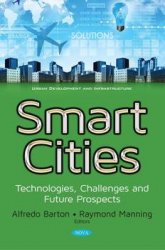Smart Cities : Technologies, Challenges and Future Prospects
- Добавил: literator
- Дата: 13-11-2017, 16:09
- Комментариев: 0
 Название: Smart Cities: Technologies, Challenges and Future Prospects
Название: Smart Cities: Technologies, Challenges and Future Prospects Автор: Alfredo Barton, Raymond Manning
Издательство: Nova Science Pub Inc
Серия: Urban Development and Infrastructure
ISBN: 1536124044
Год: 2017
Страниц: 180
Язык: английский
Формат: pdf
Размер: 10.5 MB
Существует несколько разных определений «умных городов», основанных на различных характеристиках, связанных с прилагательным «умный» и существительным «город». "Умный город" обычно включает в себя новые интеллектуальные технологические инструменты, услуги и приложения, интегрированные в платформы, обеспечивающие функциональную совместимость и координацию между несколькими секторами, которые имеют решающее значение для будущей жизни городских сообществ и оказывают воздействие на окружение.
There are several different definitions of “smart cities” based on the various characteristics related to the adjective “Smart” and the noun “City”. The Smart City commonly involves new intelligent technological tools, services and applications integrated in platforms, providing interoperability and coordination among several sectors, which are crucial for the future life of urban communities and have impacts on the environment. Chapter One describes the smart city as a concept, discusses the issues that have arisen in the post-GFC society, the need for a smart environment vision, and the importance of moving the focus from the remoteness and rigidity of national government back to a more grassroots level, while still taking advantage of the benefits offered by the technological advances that have made. Chapter Two highlights the working mechanism, advantages and disadvantages of ICT technology applied to transportation in the field of safety improvement, environmental sustainability, road redesign and traveler behavioral change. Chapter Three seeks to answer if and to what extent urban communication may be either a guarantee or a possibility to create a citizen identity. In Chapter Four, a Renewable Wireless Sensor Network (RWSN) architecture for human sensing is presented to study the spatial and temporal information of urban space utilization and pedestrian flow. Chapter Five focuses on the ways in which specific key concepts, such as those of data collection, syntax and affordance, present a dynamic intervention tool, leading to an instrumental and performative construction of a “smarter city”.
Скачать Smart Cities : Technologies, Challenges and Future Prospects
Внимание
Уважаемый посетитель, Вы зашли на сайт как незарегистрированный пользователь.
Мы рекомендуем Вам зарегистрироваться либо войти на сайт под своим именем.
Уважаемый посетитель, Вы зашли на сайт как незарегистрированный пользователь.
Мы рекомендуем Вам зарегистрироваться либо войти на сайт под своим именем.
Информация
Посетители, находящиеся в группе Гости, не могут оставлять комментарии к данной публикации.
Посетители, находящиеся в группе Гости, не могут оставлять комментарии к данной публикации.
